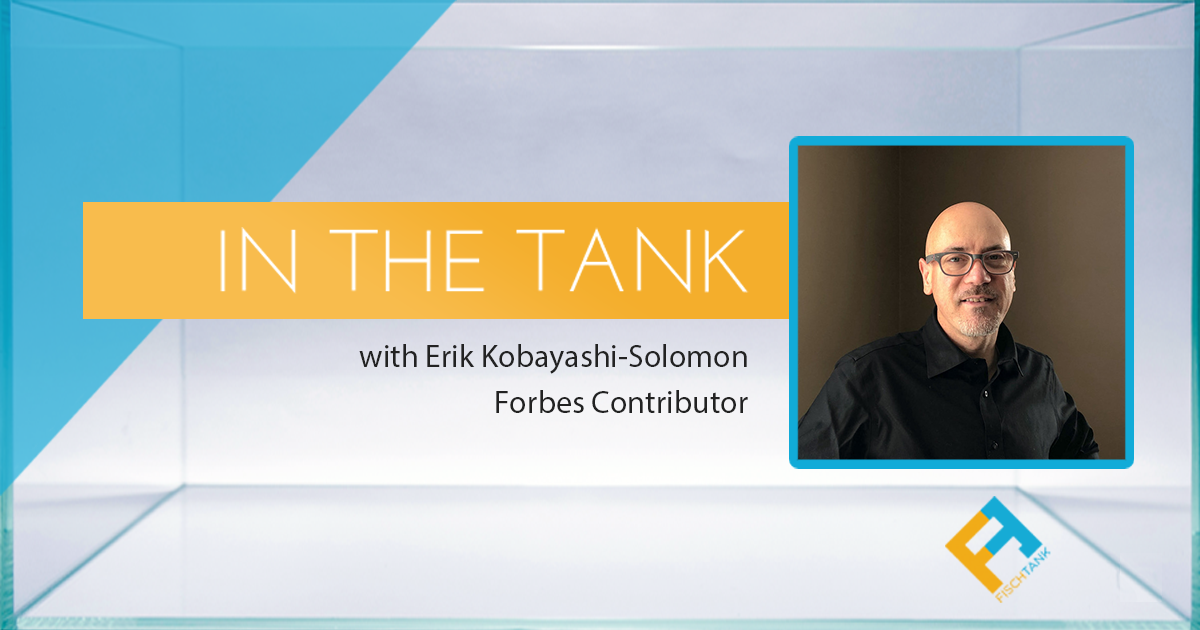This month In the Tank, we talk to Erik Kobayashi-Solomon, a Forbes contributor covering global efforts to mitigate and adapt to climate change. Erik also has a strong background in the financial sector, working as a hedge fund manager, investment banker and market strategist. He joined us to discuss how this background impacts his perspective on journalism and how he makes coverage decisions and approaches research in a rapidly changing cleantech space.
Cleantech, climate change, sustainability — there’s a lot that falls under the umbrella of renewable energy journalism. Can you explain what your typical process is for planning coverage? How do you determine focus areas or assess individual story ideas?
When I first started writing about this topic, I didn’t have much of a strategy, honestly. I would read something, get interested in it, and start researching that topic and trying to reach out to companies or organizations working in the field.
This “strategy of no strategy” was difficult for me to keep up with – there are so many interesting things to learn and write about and I realized I needed to focus in on a few key areas more carefully.
I thought back to the articles and topics that I had already written about and overlaid that with the areas I thought were most important in terms of building civilization-level resilience in the face of climate change.
Through that process, I hit upon three main areas:
- “Post-Carbon Industry” – topics that deal with either moving to a net-zero civilization (carbon credits and accounting, carbon sequestration) or with technology that will allow civilization access to the energy it needs without burning fossil fuels (renewable sources of industrial heat for concrete and glass production for instance).
- Grid Modernization and Efficiency – topics dealing with the huge challenge of electrification. This has two sides: supply and demand. We need to rethink both – supplying power more efficiently through distributed grid technology and demanding less with lifestyle changes and increasingly efficient homes and businesses.
- Agricultural Technology – How we can feed 7-9 billion people when climate change is forcing temperatures out of the range in which agriculture developed? This area covers farming, ranching, and aquaculture.
My column on Forbes is a contributor’s column, which means I have a day job as a businessperson and entrepreneur myself. What I have started doing to manage my time and resources more effectively is to think about my articles in terms of series. I’m just finishing up a series of articles about Grid Modernization and getting ready to dive into a series on carbon sequestration technologies. I spread the series out over 8-12 articles and look to provide an overarching theme (e.g., we need to get to a more highly-distributed grid system), then look at examples of companies and organizations that would fit into that theme.
Let’s go back in time for a second, if you don’t mind. You write for Forbes now (among other projects!) but you got your start in the financial sector. Can you tell us a bit about that and how those experiences influence your work as a journalist?
In fact, I really think of myself as a valuation and investment analyst. I worry that calling myself a journalist would be an insult to real journalists practicing a noble and, in my opinion, underappreciated art!
Sparing you the full, boring story, back in the mid-aughts, I was working as the market risk manager for a hedge fund with a large position in Canadian Oil Sands investments. My job was to manage the risk of that portfolio using mainly option contracts. In the process of trying to “hedge” that financial exposure, I started reading about the science of climate change and realized this was a serious issue that no one in the financial world was talking about at all.
Flash forward 12 years to 2018. I had written a book (about options), had worked as Morningstar’s Market Strategist and as an analyst, and served as the Director of Research for YCharts, a financial data start-up here in Chicago. Throughout my career, I had really only focused on the financial and markets side of things, but in my spare time, I was reading a lot about climate change and atmospheric science and getting more and more concerned. I simply didn’t see how to link the two interests – markets and sustainability.
Then, in late 2018, Bill Nordhaus at Yale won the fake Nobel Prize in Economics for his work on climate change economics. I have a lot of disagreements about Nordhaus’s view of the world, but his winning that accolade made me suddenly realize that I could combine my vocation with my avocation.
I was writing a Markets column for Forbes at the time and started writing more and more about companies providing products or services in the climate change adaptation and mitigation space.
You do a great job of rounding up and profiling companies making moves in the renewable space — how does that research process work? How do these companies usually get on your radar?
Thanks for the kind words.
The profiles that I do in Forbes are essentially just extensions of my work as an investor. As an analyst, I need to understand what the company does and, importantly, what demand environment the company is operating in.
My basic premise is that as climate change begins to affect living conditions in developed countries even more (e.g., West Coast fires, intense hurricanes, crop failures and destruction due to drought / floods, etc.), the demand for services provided by companies in this space will have a very sudden and notable inflection point.
What I’m trying to do when I look at companies is understand how close that company is to an inflection point and in what circumstances. I also want to make sure that the business makes sense even if that inflection point doesn’t come as soon as the founders / managers think. Is the business’s success predicated on a carbon tax of $60 / ton of CO2 equivalent and will lose money until that point? If so, that company holds less interest for me because who knows what’s going to happen to carbon taxes!
Also, I am interested in how novel the technology is and whether the company is simply a glorified science fair experiment or if it is an actual, viable business that will help civilization adapt to and thrive in the next century. It’s a pretty high bar.
As for how the companies come to my attention, I have around 1,000 pitch mails in one of my email accounts right now. I’m trying to work through that stack a little bit at a time, but more mails keep coming in.
I do find that if I’m talking to people who are integral to a certain industry, they know which companies are doing important things and often introduce me to principals at those firms.
This is, honestly, one of the most difficult and stressful parts of my job and one that I don’t think I’ve figured out yet. I’d like to be able to scan all the pitches and set aside the companies that interest me in learning more about, return to them when I have the bandwidth to dive into an analysis, then pull them out and start work. Just like in investing, though, trying to manage information flows is the most challenging part of the game.
Your coverage is also very data-driven, something that’s so important when looking at renewable energy projects and technologies. Can you shed some light on what you look for when assessing companies, projects and other efforts from that perspective?
This really goes back to what I was mentioning before. I am focused especially on what the demand environment is like and whether the company’s products and services make sense in terms of what I know about the area in which it operates.
Again, I don’t think of myself as a journalist, but as an analyst, so I want to get a sense of how large the market is, what other technologies have been developed to solve the problems that the company in question is trying to solve, and what the likelihood is that the company will be able to scale its solution profitably.
I would also say that, simply because of the focus areas I’ve chosen for myself, I am looking for projects that will end up having a very large impact on the biggest problems facing civilization right now.
The arc of the story must work on all these levels – the problem must be big, the solution must be novel, the company must be on a path to solve that problem with the right people and funding. To understand each of the levels, I like to understand what the enterprise looks like from a data perspective.
I’ve gotta ask — PR people, how do you prefer to work with them? Any big likes or dislikes about typical processes we should know about?
In fact, I’m trying to figure this question out myself as well. Most of the time, PR people contact me wanting me to amplify a particular event or milestone. This is hard for me to do much with because I am generally trying to do a more in-depth piece that is less tied to a particular announcement.
One of the problems is that, since journalism is not my “main gig”, I am not great at working through breaking news kinds of stories, simply because I don’t have the bandwidth to juggle what’s going on in my primary business with the news flow from a lot of start-ups and established companies in a certain industry.
If I had my druthers, I would tell PR folks what I’m working on — right now, that’s carbon sequestration, followed by a look at the carbon footprint of our food system — and I would get some information from the PR folks about companies they think might fit into these categories. I could set that information aside, then start working through an analysis of the companies when I was ready to start writing on that topic.
That set-up gives me a lot of upside — I basically get a free call option on information about a company that I might be interested in — but probably is not as great for PR folks, I know. For instance, I had originally thought that I would be writing about carbon sequestration in April of this year. It’s early May right now and I haven’t even started that series yet.
I understand that PR people need to show their clients that they are representing the clients’ interests to members of the press and the only way to really do this is to show that they have successfully placed mention of a company in this or that outlet. I also understand that telling a client “Erik at Forbes is interested in what you’re doing and might get around to writing a story in October of this year” rings a bit hollow.
I’d like to be able to balance that timing difference better, but so far, I haven’t figured out how to do it as well as I’d like.
Alright, last question! Tell us about your favorite story from the past year, what made researching and writing it so interesting?
The story that jumps to mind right now is the series of stories about Grid Modernization. I learned so much from talking to some really interesting people. I had never even thought, for instance, that open-source software might have a role in grid optimization or that such a thing as a software-powered “Virtual Power Plant” existed.
Doing the research was a great education for me and I hope my readers found the topic interesting and important as well. In that series, I also tried my hand in a new medium — video — it’s a lot of work for me to pull the videos together, but it is also a fun, conversational way to communicate and something I’d like to explore more. Watch it here: https://vimeo.com/528612121
To keep up with Erik Kobayashi-Solomon, follow him on Twitter, connect with him on LinkedIn or check out his byline at Forbes.
Interested in sharing your insights in journalism, marketing, PR firms or communications in a future installment of In the Tank? Drop us a line.




